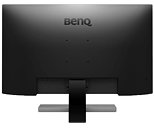Raevenlord
News Editor
- Joined
- Aug 12, 2016
- Messages
- 3,755 (1.16/day)
- Location
- Portugal
| System Name | The Ryzening |
|---|---|
| Processor | AMD Ryzen 9 5900X |
| Motherboard | MSI X570 MAG TOMAHAWK |
| Cooling | Lian Li Galahad 360mm AIO |
| Memory | 32 GB G.Skill Trident Z F4-3733 (4x 8 GB) |
| Video Card(s) | Gigabyte RTX 3070 Ti |
| Storage | Boot: Transcend MTE220S 2TB, Kintson A2000 1TB, Seagate Firewolf Pro 14 TB |
| Display(s) | Acer Nitro VG270UP (1440p 144 Hz IPS) |
| Case | Lian Li O11DX Dynamic White |
| Audio Device(s) | iFi Audio Zen DAC |
| Power Supply | Seasonic Focus+ 750 W |
| Mouse | Cooler Master Masterkeys Lite L |
| Keyboard | Cooler Master Masterkeys Lite L |
| Software | Windows 10 x64 |
BenQ announced availability of their EW3270U desktop PC monitor, which features some well-known quantity in terms of features. The panel itself is a 31.5" affair built upon VA technology, and features 4K resolution (3840 x 2160). There's a 3000:1 contrast ratio, a measly 300 cd/m² brightness (so no, this monitor can't really display HDR content, it can only receive HDR input), a 9 ms response time (with 4 ms gray-to-gray).
There's a somewhat interesting technology at play here though, which BenQ calls Brightness Intelligence Plus Technology (B.I.+ Tech). This tech should somewhat have the unintended effect of wreaking havoc with content: it automatically darkens bright areas so as to reduce contrast with the dark ones. FreeSync was thrown into the display as well, though that should do little to improve its gaming monitor chops. Connectivity-wise, we're looking at a pretty standard 1xDisplayPort 1.2 x, 2x HDMI 2.0, 1x USB-C, and a 3.5 mm audio jack.



View at TechPowerUp Main Site
There's a somewhat interesting technology at play here though, which BenQ calls Brightness Intelligence Plus Technology (B.I.+ Tech). This tech should somewhat have the unintended effect of wreaking havoc with content: it automatically darkens bright areas so as to reduce contrast with the dark ones. FreeSync was thrown into the display as well, though that should do little to improve its gaming monitor chops. Connectivity-wise, we're looking at a pretty standard 1xDisplayPort 1.2 x, 2x HDMI 2.0, 1x USB-C, and a 3.5 mm audio jack.



View at TechPowerUp Main Site




 )
)